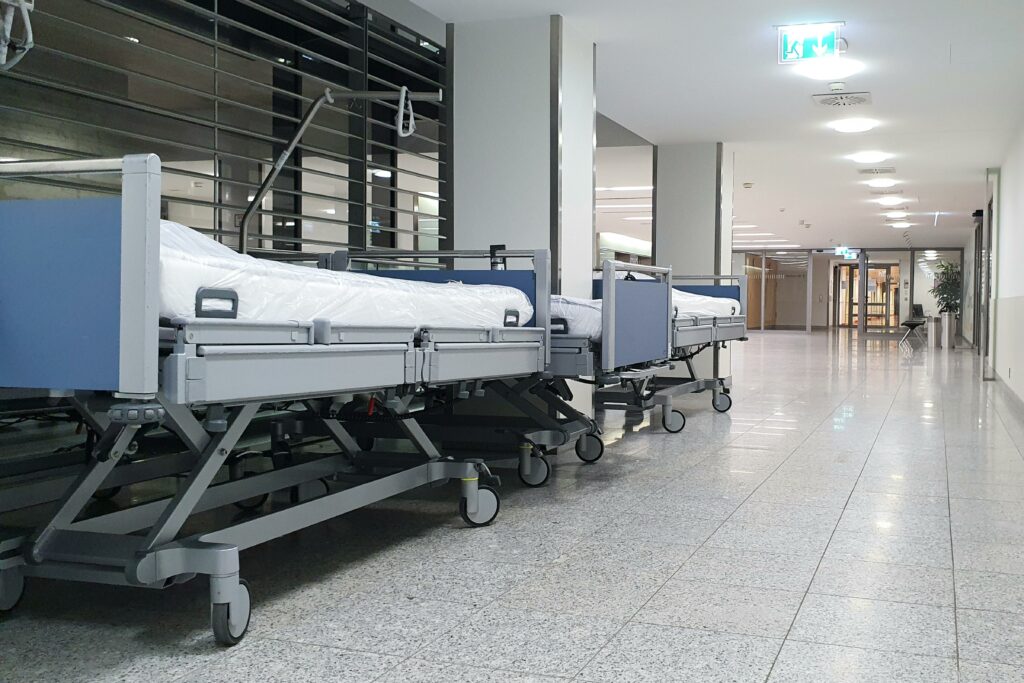Missing psychiatric drugs causes unique problems because of the nature of the nervous system. Nerve signaling relies on neurotransmitters, small molecules that pass between neurons to initiate electrical transmissions. Receptors on the receiving neuron bind the neurotransmitter, and the number of receptors controls the strength of the signaling. Psychiatric drugs often change the amount of neurotransmitters present, and in response, the body will either increase or decrease the number of neurotransmitters to maintain a steady state. When people do not take their medications, the neurotransmitter levels return to their initial states, but the receptor levels lag. The result is either an extreme excess or deficiency of signaling, which can lead to severe physical and mental suffering and even psychosis. In surveys, non-adherent patients describe “complete insomnia and crushing anxiety,” having “a full-blown panic attack but spread out over several days,” and being on “a roller coaster from hell.” An Australian man suffering from non-adherence withdrawal “want[ed] to commit suicide just to end the internal torment.” In Canada, psychiatric drugs are the most frequently missed class of medication.

Emergency Signage. Free to use under the Pexels license.
The majority of Canadians hold the opinion that healthcare in this country is struggling. Most Canadians do not believe they will have access to good medical attention. Unprompted, 66% of Canadians will volunteer wait times as a reason for failures in the healthcare system. They are right. According to government trackers, hospital wait times usually sit between two and six hours, although they can run as high as twenty hours in extreme cases. Physicians are overstretched and low on morale, compromising care across the board. Estimates based on data from the U.K. suggest that 15,000 people may die per year as a result of long waits. Wait times are a complex problem with many contributing factors. Hospitals are understaffed and lack beds and other infrastructure to ensure efficiency. Many hospitals still use faxes. Many people spill over to hospitals because of a lack of primary care. For numerous reasons, people do not fill or do not take their prescriptions, leading to emergency interventions. Studies on missing medication often claim it to be a global reason for unnecessary medical strain. Hospitals are forced to intervene in what should be preventable conditions. These interventions strain emergency rooms and represent a broader failure of policy. Single-payer pharmacare promises to bring everyone onto drug insurance, lower the cost of medications, and relieve pressure on the clinical system.
It is a common misconception that this country has universal health care. In reality, Canada has universal clinical care. Provincial services cover the vast majority of surgeries, emergency visits, annual checkups, and other aspects of clinical care up to a federal standard. Within the clinical setting, the province covers drugs administered during treatment. Outside of clinical care, pharmacare coverage in Canada is similar to healthcare coverage in the United States. Private plans cover much of the population. Public plans cover some marginalized populations and select medications, although the degree of coverage varies across provinces. For example, Ontario’s Drug Benefit program covers those in assisted living programs and those under 24 years of age from the province’s index of approved medications.
The Ontario Drug Benefit program works with three other provincial programs—Ontario Works, the Ontario Disability Support Program, and the Trillium Drug Program. These programs provide coverage for poor people, people with disabilities, and specific high-cost medications, respectively. British Columbia has a similar system, although the province subdivides its programs differently and has a slightly different drug index because, until recently, there has been no federal standard for approved drugs. Public pharmacare schemes like these account for 45% of national drug expenditures. Out-of-pocket and private plans—accessed independently or through employment—account for the remaining portion of pharmacological coverage. 20% of total spending is out of pocket, and 35% goes through private insurance companies.
Out-of-pocket spending and insurance status are predictors of medication non-adherence: when patients do not take their medication as they and their physician have agreed to. Non-adherence is primary when the patient never fills a prescription and secondary when the patient deviates from their plan in some other way. The patient may stop taking the drugs altogether, take their drugs after a planned time, or ration their drugs.

Close-up Photo of Medicinal Drugs. Free to use under Pexels License.
Subtypes of non-adherence rates make the subject tough to research. Meta-analyses are the best tools for measuring population trends, as they allow researchers to collate more data, but they also rely on shared definitions in scientific literature. If an initial study only examined primary non-adherence, the researchers cannot group it with another study that examines secondary non-adherence. Frustratingly, in this area of research, both studies might describe their focuses as just non-adherence. Because definitions of non-adherence are not standard, specific data on the burden of non-adherence in Canadian emergency rooms are difficult to verify. This also makes searching for individual studies challenging because search results do not match to search terms. We need to use international figures on non-adherence factors and healthcare burdens. What data exist are variable. What is clear is that deviating from the course of treatment can have devastating side effects.
For people with diabetes, supplemental insulin saves lives and preserves people’s well-being. Over decades, high levels of blood glucose damage nerves and blood vessels in the body. Fine capillaries in the kidneys and eyes are often affected. In the kidneys, the glomerulus, a capillary ball that allows filtrate to pass from the blood and into the channels of the kidney, becomes damaged and incapable of fluid exchange. This diabetic nephropathy is a common condition among diabetic people. Carried to extremes, it will lead to kidney failure and death. In the eyes, damage to the vascular network leads to bleeding around the retina, the receptive field of the eye. Bleeding in the eye and a lowered blood flow cause blindness over time. Damage to nerves results in a lack of feeling, often in the feet. Low blood flow from capillary damage makes tissue vulnerable to infection, infections people fail to notice because of nerve damage. These infections spread and turn into diabetic ulcers—large, open, festering sores penetrating to the bone—resulting in amputations and sepsis. Fortunately, the recent Pharmacare Act came into effect in October of 2024, which will work to provide universal access to diabetes medications. Hopefully, this will reduce the incidence of diabetic diseases.
In developed nations, cardiovascular medications are among the most commonly skipped. These medications often act to reduce levels of cholesterol in the blood. Cholesterol builds plaques in blood vessels, obstructing blood flow and stiffening arteries that need to be supple to manage changes in blood pressure. If the obstruction is in the blood vessels supplying the heart muscle, the person will be at risk of a heart attack. If medical workers catch the heart disease in time, the person may have surgery to create an alternate route for blood. A surgical team would cut the sternum (breastbone) open, harvest veins and arteries from around the body for macabre plumbing, and stitch and slam large needles into the heart to establish bypass, all as part of an hours-long effort. These patients are lucky. The onset of their disease was slow enough for healthcare workers to intervene. Others are less fortunate. Cardiovascular disease is the leading cause of death in developed nations.

Doctor Operating on a Patient. Free to use under the Pexels license.
A variety of sources, including the Canadian government and independent studies, estimate that between 5-15% of the population is medication non-adherent. Of course, non-adherence varies on the provincial level and within populations. British Columbia has the highest rate of non-adherence within the provinces, between 17-26% depending on the estimate. Nova Scotia has the lowest at around 14%. A meta-review estimated non-adherence to account for 4.4% of hospital admissions in developed countries. If (given that this specific figure could not be found) the rate of hospital admissions can approximate the rate of emergency admissions, then total non-compliance would account for 660,000 extra visits per year. It is tempting to stop here and say that implementing universal pharmacare would relieve about 5% of emergency room visits. However, this would not be an accurate view of the impact of universal pharmacare. Medication non-adherence results from cost-related and non-cost-related factors, and it stands to reason that only the cost-related portion would be affected by universal pharmacare.
Non-cost-related medication non-adherence is dependent on demographics and the nature of the prescribed medications. Older patients are less likely to be adherent than younger patients. The patient’s relationship with the prescribing physician is relevant. People are more likely to follow their agreed plan if they are the same sex as their physician—an effect more pronounced for male patients. The complexity of the prescription will alter adherence. Patients with more drugs or who have to take drugs at shorter intervals are less likely to take their prescriptions.
If the side effects of medications are adverse, patients may stop taking the prescriptions they filled. Primary adherence is highest for cardiovascular drugs. People fill their initial prescriptions, but they do not take the medications for long. Many cardiovascular drugs are statins, a class of medications with unpleasant side effects like aches and nausea. Because of the side effects, patients often forgo their statins during treatment, and so the rate of secondary non-adherence is very high. The result is that long-term adherence to cardiovascular drugs is among the lowest for all classes of medication. While non-adherence may account for roughly 4% of admissions, universal pharmacare would solve none of the above non-cost-related factors. The elderly would still skip their medications. Patients would still ignore their physicians, discontinue uncomfortable drugs, and neglect complex regimens. Therefore, the number of emergency cases prevented through universal pharmacare is likely marginal.
When patients do not fill prescriptions or ration medication because they cannot afford the price, that is cost-related non-adherence. The strongest predictors of non-adherence are all cost-related. The out-of-pocket cost faced because of co-payments, deductibles, or being uninsured is the most accurate single predictor of non-adherence. People are less likely to buy drugs that cost them more money. In Québec, the introduction of co-payments caused an increase in non-adherence and emergency visits. Nation-wide, a study on the effects of drug pricing schemes in Canada estimated that there are 93,000 preventable emergency room visits each year because of cost-related non-compliance, or about 0.6% of the total 15 million emergency visits.

Close-up of Pills and Cash. Free to use under the Pexels License.
With expected gains at a modest 0.6%, universal pharmacare could increase, not decrease wait times in the healthcare system. Patients with drug insurance are more likely to assess clinical care than those without. Those who can afford to fill prescriptions will seek prescriptions for their ailments. Canada’s 20% previously uninsured population would exacerbate backlogs in clinical care and create further spillover onto emergency care. Universal pharmacare would not be a panacea for healthcare clinics in Canada. In the best-case scenario, less than 5% of hospital patients would be relieved, and there would be no increased burden. The best-case scenario will not happen. Does that matter, though?
Delays of care are a problem because they represent a deficit in the system. Other systemic deficits are worth fixing even if they are not a fix-all solution. Recently, the government has made progress through the passage of the Pharmacare Act, which provides coverage for contraceptive and diabetes medications. The Pharmacare Act is a decent first step, but the law aims to deliver drugs at the provincial level, as is the case with clinical care. More than clinical care, pharmacare benefits from single-payer systems because the government gains negotiating power against drug companies. A unified negotiator lowers the price of drugs beyond what can occur through an open market. To ensure an efficient and universal system in the future, the federal government must work to unify the provinces into a single negotiating bloc to provide comprehensive pharmaceutical coverage to its citizens. Millions of Canadians skip meals, leave their homes unheated, and cut other essential services every year to afford their medications. 20% of Canadians lack drug insurance. Yearly out-of-pocket costs for drugs sum to 6.5 billion dollars. In Ontario alone, hundreds of people die from complications from diabetes each year. People go blind, lose limbs, suffer mental anguish, and die because the government does not cover the cost of their medications. Even if universal pharmacare exacerbates clinical wait times, it is still worth implementing for the millions of Canadians who need care.




















This article discusses the issue of over-crowding and long wait times in the Canadian healthcare system. A statistic I found…